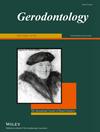Toothbrushing-induced vestibular ulcerations with severe gingival defects
Abstract
Background
Daily toothbrushing is a routine approach for helping to keep the oral cavity healthy. However, using a toothbrush as an ordinary oral hygiene habit can also lead to adverse events.
Case Presentation
A 75-year-old man was referred by a periodontist for vestibular ulcerations with gingival defects. The patient reported no significant medical or social history, which might be associated with his symptoms. On examination, wide labio-buccal gingival defects, white attached gingiva and linear vestibular ulcerations were observed. With the help of the periodontist, a diagnosis of inappropriate toothbrushing-induced traumatic ulcerations was reasoned via an approach of aetiological elimination. The patient was put on a trial course of topical dexamethasone powder with lincomycin. The resolution of vestibular ulcerations was apparent after two weeks. He reported no similar oral ulcerations during the following nine years.
Conclusion
To our knowledge, this is the first case reported in the literature of vestibular ulcerations with severe gingival defects caused by inappropriate toothbrushing. The establishment of a correct diagnosis needs a close collaboration between periodontists and oral medicine specialists. Instruction on correct toothbrushing, especially for older people can be beneficial.

 求助内容:
求助内容: 应助结果提醒方式:
应助结果提醒方式:


